Modeling Brittle Fractures in Epoxy Nanocomposites Using Extended Finite Element and Cohesive Zone Surface Methods
Abstract
1. Introduction
2. Materials and Methods
2.1. Fracture Model and System Layout
2.2. Surface-Based Cohesive Zone Model
2.3. Extended Finite Element Method
2.4. Simulation Parameters
3. Results and Discussion
4. Conclusions
Supplementary Materials
Author Contributions
Funding
Institutional Review Board Statement
Informed Consent Statement
Data Availability Statement
Acknowledgments
Conflicts of Interest
Abbreviations
| CZS | Surface-based cohesive zone method |
| FRPC | Fiber-reinforced polymer composite |
| LEFM | Linear elastic fracture mechanics |
| LLD | Load-line displacement |
| MAXPS | Maximum principal stress |
| QUADS | Quadratic nominal stress |
| SENB | Single-edge notched bending |
| TSL | Traction-separation law |
| XFEM | Extended finite element method |
References
- Crawford, E.; Lesser, A.J. The effect of network architecture on the thermal and mechanical behavior of epoxy resins. J. Polym. Sci. Part B Polym. Phys. 1998, 36, 1371–1382. [Google Scholar] [CrossRef]
- Bain, E.D.; Knorr, D.B.; Richardson, A.D.; Masser, K.A.; Yu, J.; Lenhart, J.L. Failure processes governing high-rate impact resistance of epoxy resins filled with core–shell rubber nanoparticles. J. Mater. Sci. 2015, 51, 2347–2370. [Google Scholar] [CrossRef]
- Wang, Z.; Liu, F.; Liang, W.; Zhou, L. Study on tensile properties of nanoreinforced epoxy polymer: Macroscopic experiments and nanoscale FEM simulation prediction. Adv. Mater. Sci. Eng. 2013, 2013, 1–8. [Google Scholar] [CrossRef]
- Elruby, A.Y.; Nakhla, S. Strain energy density based damage initiation in heavily cross-linked epoxy using XFEM. Theor. Appl. Fract. Mech. 2019, 103, 102254. [Google Scholar] [CrossRef]
- Belytschko, T.; Gracie, R.; Ventura, G. A review of extended/generalized finite element methods for material modeling. Model. Simul. Mater. Sci. Eng. 2009, 17, 043001. [Google Scholar] [CrossRef]
- Moës, N.; Dolbow, J.; Belytschko, T. A finite element method for crack growth without remeshing. Int. J. Numer. Methods Eng. 1999, 46, 131–150. [Google Scholar] [CrossRef]
- Duarte, A.P.C.; Sáez, A.D.; Silvestre, N. Comparative study between XFEM and Hashin damage criterion applied to failure of composites. Thin Walled Struct. 2017, 115, 277–288. [Google Scholar] [CrossRef]
- Elices, M.; Guinea, G.; Gómez, J.; Planas, J. The cohesive zone model: Advantages, limitations and challenges. Eng. Fract. Mech. 2002, 69, 137–163. [Google Scholar] [CrossRef]
- Petrov, N.A.; Gorbatikh, L.; Lomov, S.V. A parametric study assessing performance of eXtended finite element method in application to the cracking process in cross-ply composite laminates. Compos. Struct. 2018, 187, 489–497. [Google Scholar] [CrossRef]
- ASTM International. ASTM D638-14, Standard Test Method for Tensile Properties of Plastics; ASTM International: West Conshohocken, PA, USA, 2014. [Google Scholar]
- ASTM International. ASTM D5045-14, Standard Test Methods for Plane-Strain Fracture Toughness and Strain Energy Release Rate of Plastic Materials; ASTM International: West Conshohocken, PA, USA, 2014. [Google Scholar]
- Wangz, W.H.; Greer, A.L. Intrinsic plasticity or brittleness of metallic glasses. Philos. Mag. Lett. 2005, 85, 77–87. [Google Scholar] [CrossRef]
- Barenblatt, G.I. The mathematical theory of equilibrium cracks in brittle fracture. Adv. Appl. Mech. 1962, 7, 55–129. [Google Scholar] [CrossRef]
- Ramamurthi, M.; Lee, J.; Yang, S.; Kim, Y. Delamination characterization of bonded interface in polymer coated steel using surface based cohesive zone model. Int. J. Precis. Eng. Manuf. 2013, 14, 1755–1765. [Google Scholar] [CrossRef]
- Wang, C.H.; Duong, C.N. Damage tolerance and fatigue durability of scarf joints. In Bonded Joints and Repairs to Composite Airframe Structures; Elsevier: Amsterdam, The Netherlands, 2016; pp. 141–172. [Google Scholar]
- Li, J.; Yang, S.; Li, D.; Chalivendra, V. Numerical and experimental studies of additively manufactured polymers for enhanced fracture properties. Eng. Fract. Mech. 2018, 204, 557–569. [Google Scholar] [CrossRef]
- Scheider, I.; Brocks, W. The effect of the traction separation law on the results of cohesive zone crack propagation analyses. Key Eng. Mater. 2003, 251–252, 313–318. [Google Scholar] [CrossRef]
- Anyfantis, K.; Tsouvalis, N.G. A novel traction–separation law for the prediction of the mixed mode response of ductile adhesive joints. Int. J. Solids Struct. 2012, 49, 213–226. [Google Scholar] [CrossRef]
- Turon, A.; Dávila, C.; Camanho, P.; Costa, J. An engineering solution for mesh size effects in the simulation of delamination using cohesive zone models. Eng. Fract. Mech. 2007, 74, 1665–1682. [Google Scholar] [CrossRef]
- Ghandriz, R.; Hart, K.; Li, J. Extended finite element method (XFEM) modeling of fracture in additively manufactured polymers. Addit. Manuf. 2020, 31, 100945. [Google Scholar] [CrossRef]
- Benzeggagh, M.L.; Kenane, M. Measurement of mixed-mode delamination fracture toughness of unidirectional glass/epoxy composites with mixed-mode bending apparatus. Compos. Sci. Technol. 1996, 56, 439–449. [Google Scholar] [CrossRef]
- Tourlomousiss, I.; Theotokoglou, E.E. A finite element analysis of fractured sandwich composites structures under small scale yielding. Mater. Sci. Eng. Int. J. 2019, 3, 45–49. [Google Scholar] [CrossRef][Green Version]
- Iowa State University Center for Nondestructive Evaluation. Fracture Toughness. Physics of Nondestructive Evaluation. 2021. Available online: https://www.nde-ed.org/Physics/Materials/Mechanical/FractureToughness.xhtml (accessed on 17 August 2021).
- Krueger, R.; Minguet, P.J. Influence of 2D finite element modeling assumptions on debonding prediction for composite skin-stiffener specimens subjected to tension and bending. Compos. Struct. 2002, 57, 161–168. [Google Scholar] [CrossRef][Green Version]
- Hütter, G.; Zybell, L.; Kuna, M. Micromechanical modeling of crack propagation with competing ductile and cleavage failure. Procedia Mater. Sci. 2014, 3, 428–433. [Google Scholar] [CrossRef]
- Hashiguchi, K. Multiplicative hyperelastic-based plasticity for finite elastoplastic deformation/sliding: A comprehensive review. Arch. Comput. Methods Eng. 2018, 26, 597–637. [Google Scholar] [CrossRef]
- Mavrodontis, N. Converting Engineering Stress-Strain to True Stress-Strain in Abaqus. 2017. Available online: https://info.simuleon.com/blog/converting-engineering-stress-strain-to-true-stress-strain-in-abaqus (accessed on 1 June 2020).
- Ling, Y. Uniaxial true stress-strain after necking. AMP J. Technol. 1996, 5, 37–48. [Google Scholar]
- Paul, S.K.; Roy, S.; Sivaprasad, S.; Tarafder, S. A simplified procedure to determine post-necking true stress-strain curve form uniaxial tensile test of round metallic specimen using DIC. J. Mater. Eng. Perform. 2018, 27, 4893–4899. [Google Scholar] [CrossRef]
- Roylance, D. Yield and plastic flow. In Mechanical Properties of Materials; Massachusetts Institute of Technology: Cambridge, MA, USA, 2008; pp. 79–104. [Google Scholar]
- Abadyan, M.; Bagheri, R.; Kouchakzadeh, M.; Kordkheili, S.H. Exploring the tensile strain energy absorption of hybrid modified epoxies containing soft particles. Mater. Des. 2011, 32, 2900–2908. [Google Scholar] [CrossRef]
- Li, S.; Abdel-Wahab, A.; Demirci, E.; Silberschmidt, V.V. Fracture process in cortical bone: X-FEM analysis of microstructured models. Int. J. Fract. 2013, 184, 43–55. [Google Scholar] [CrossRef]
- Vorel, J.; Kabele, P. Inverse analysis of traction-separation relationship based on sequentially linear approach. Comput. Struct. 2018, 212, 125–136. [Google Scholar] [CrossRef]

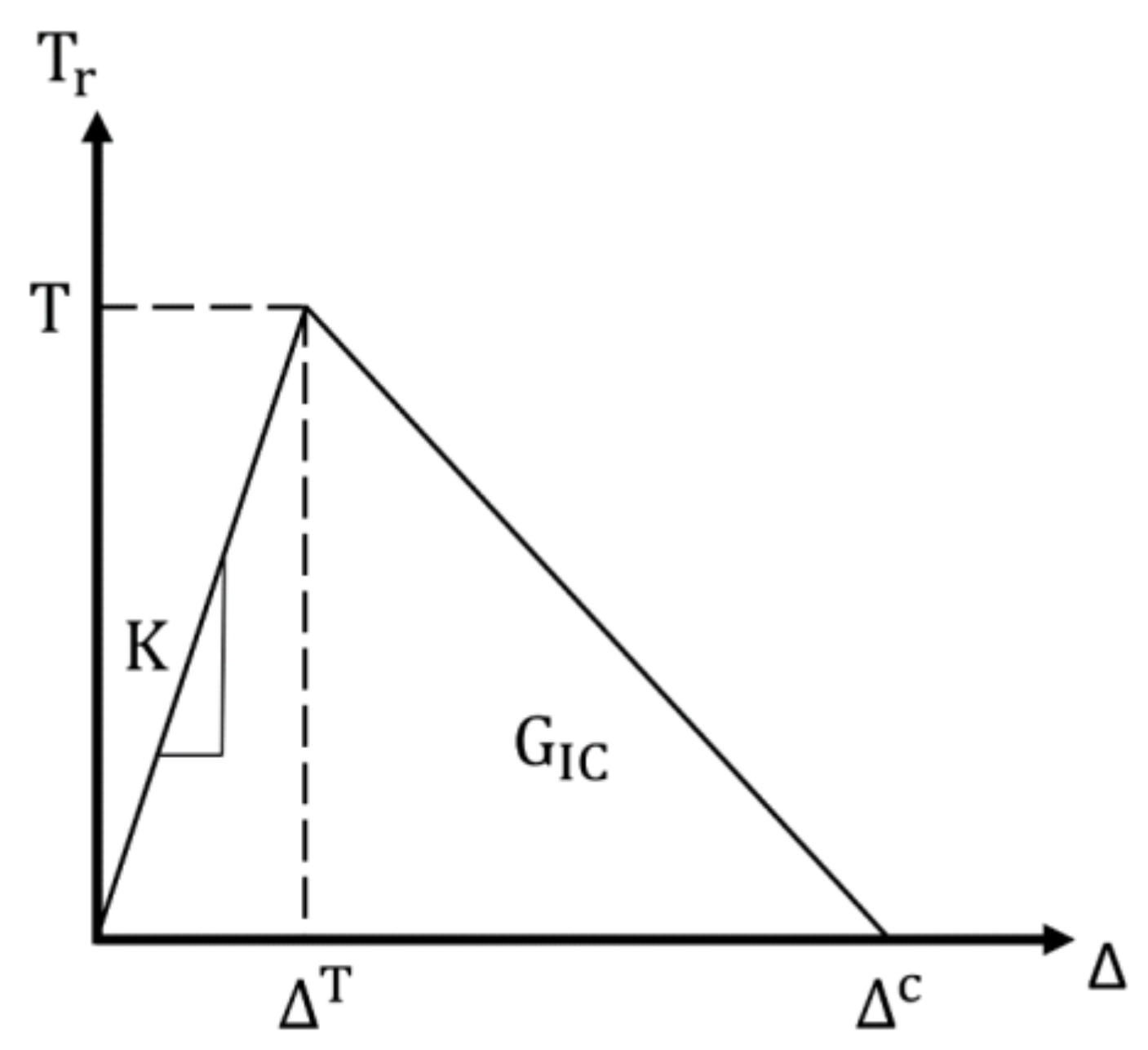
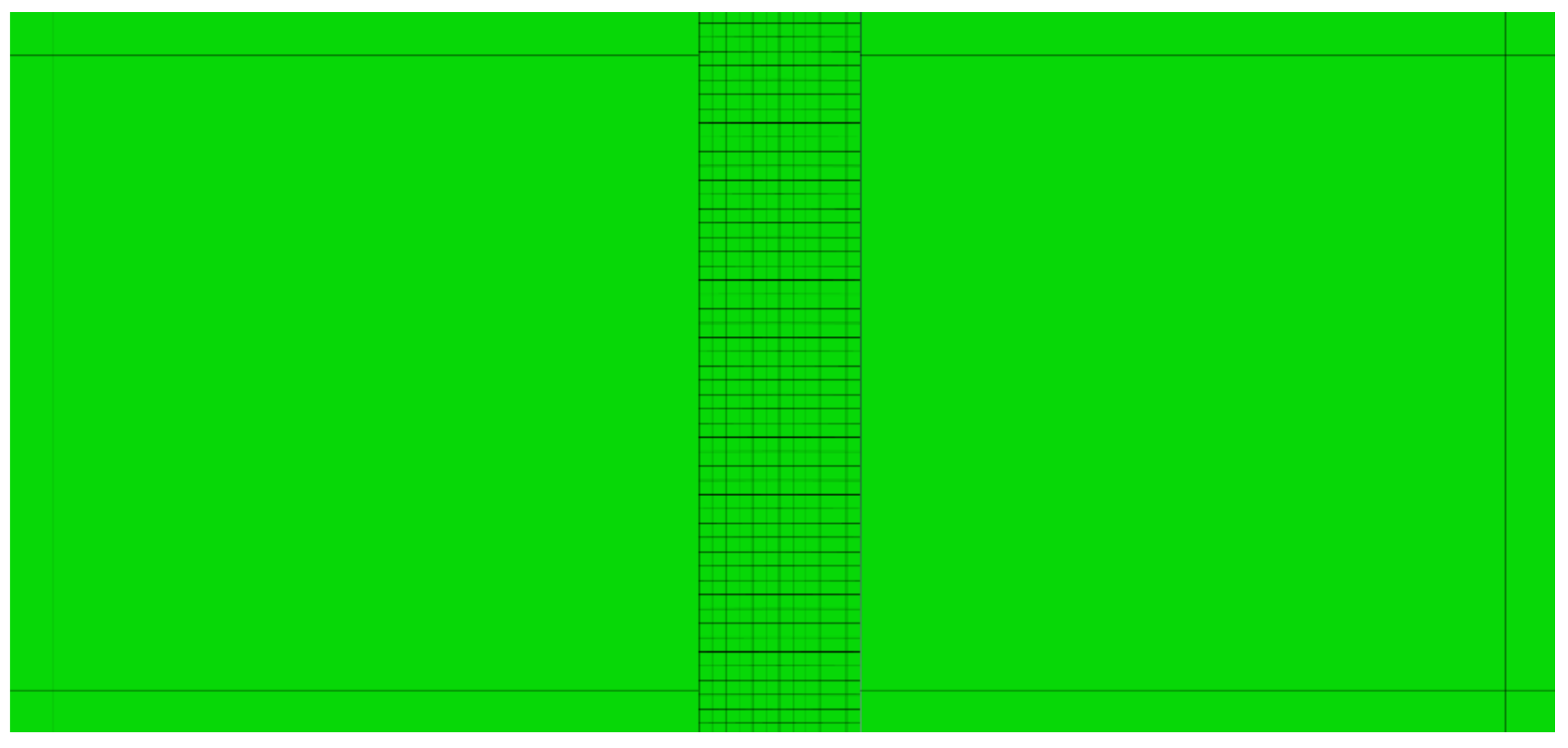
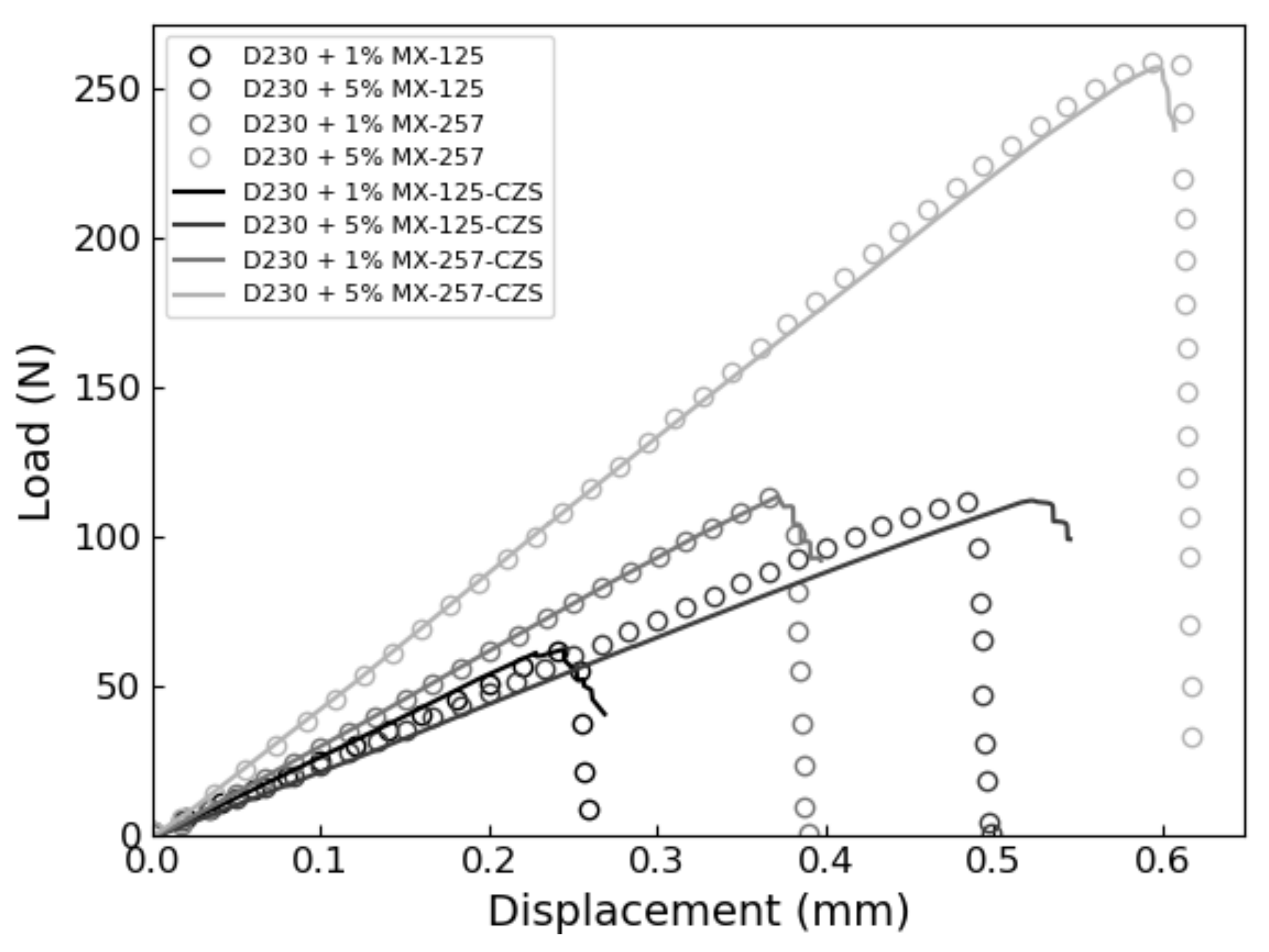
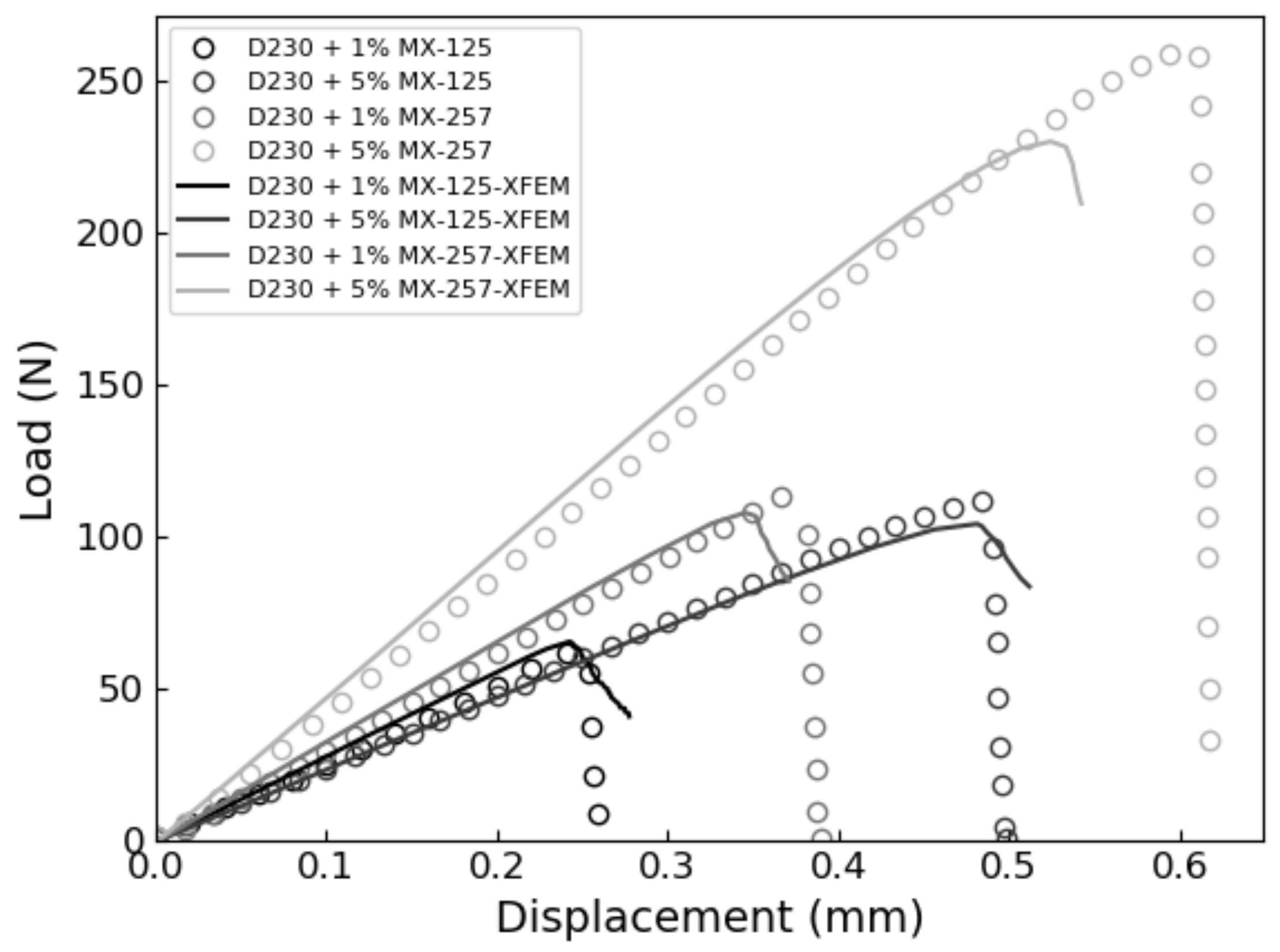
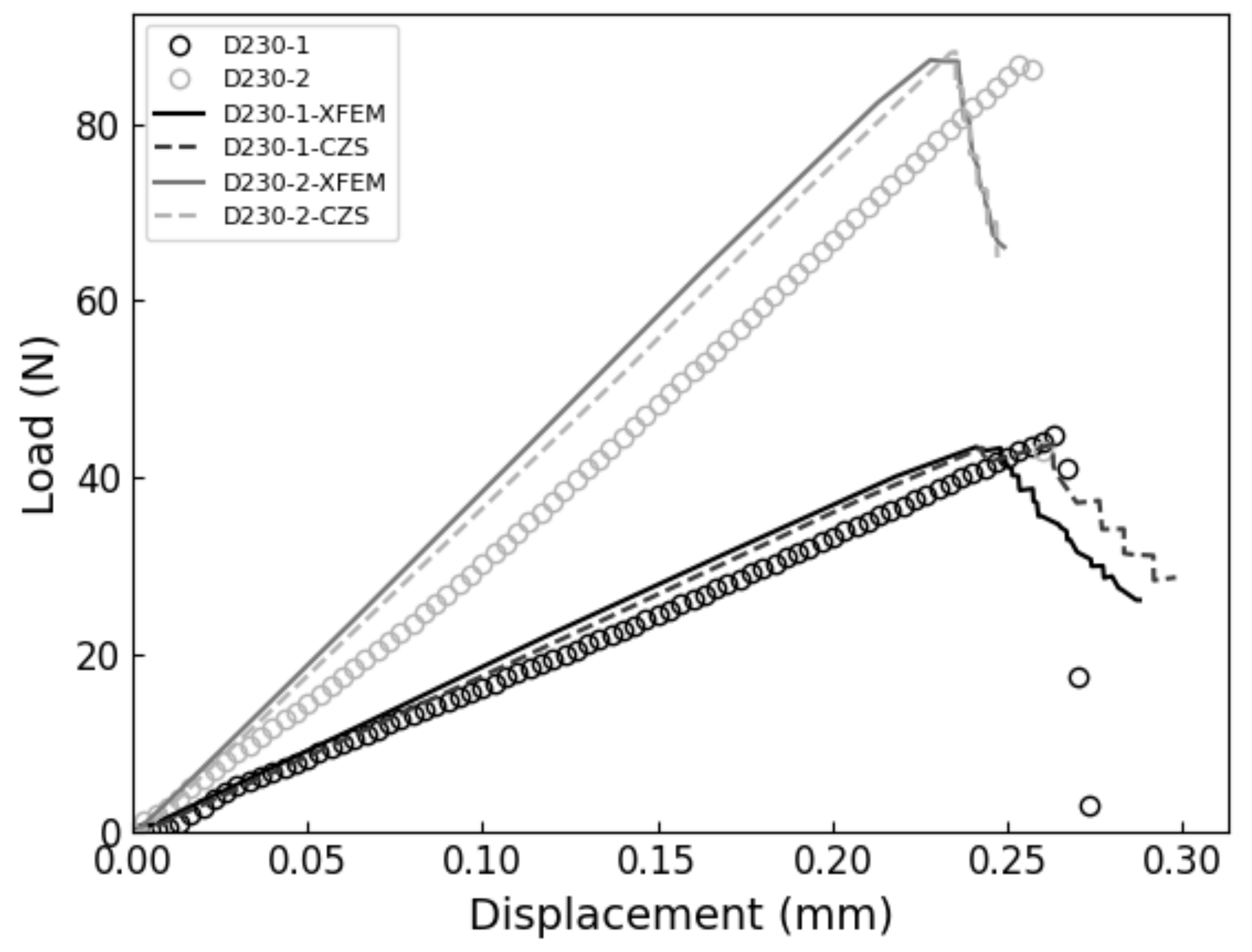
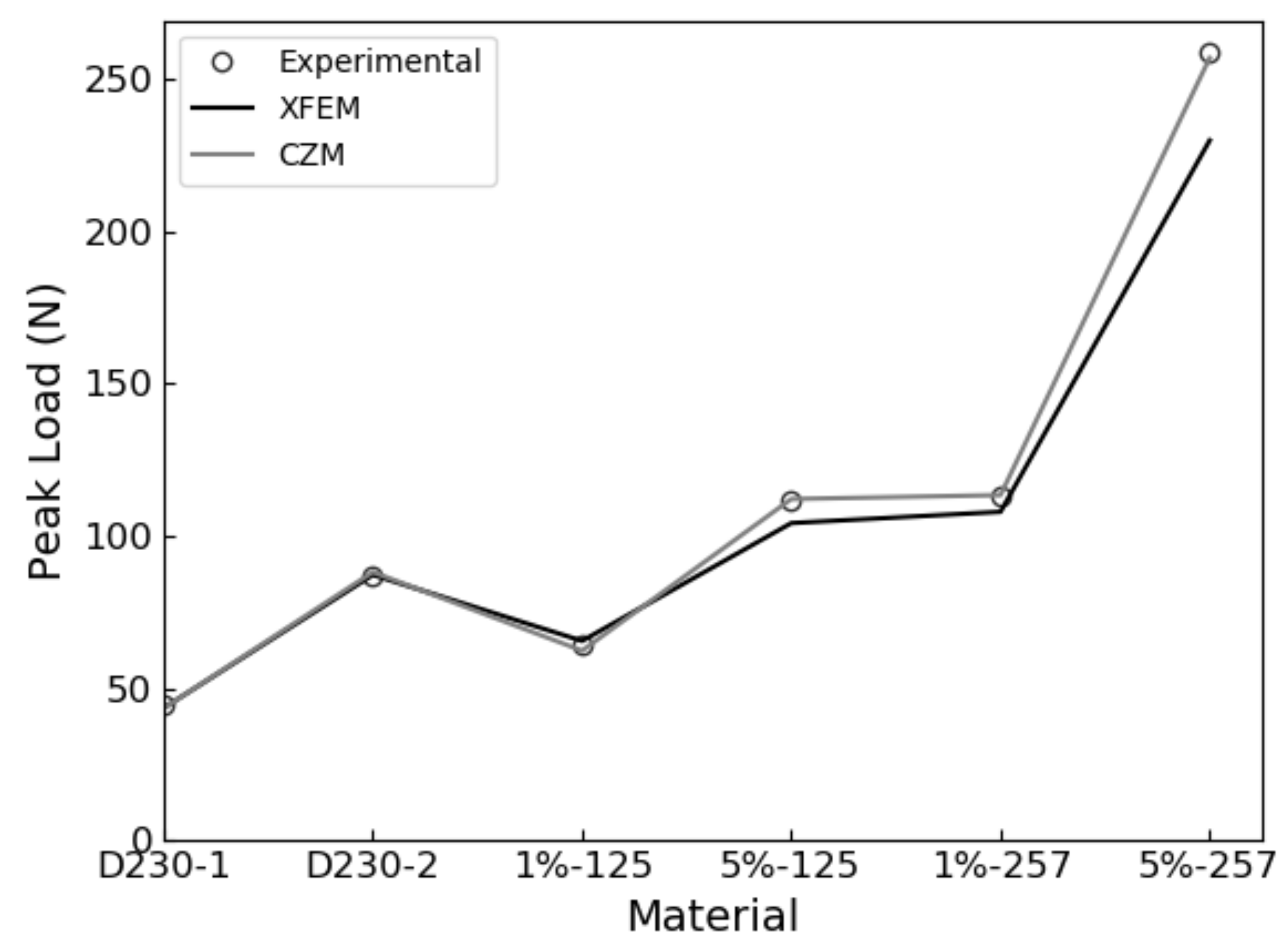

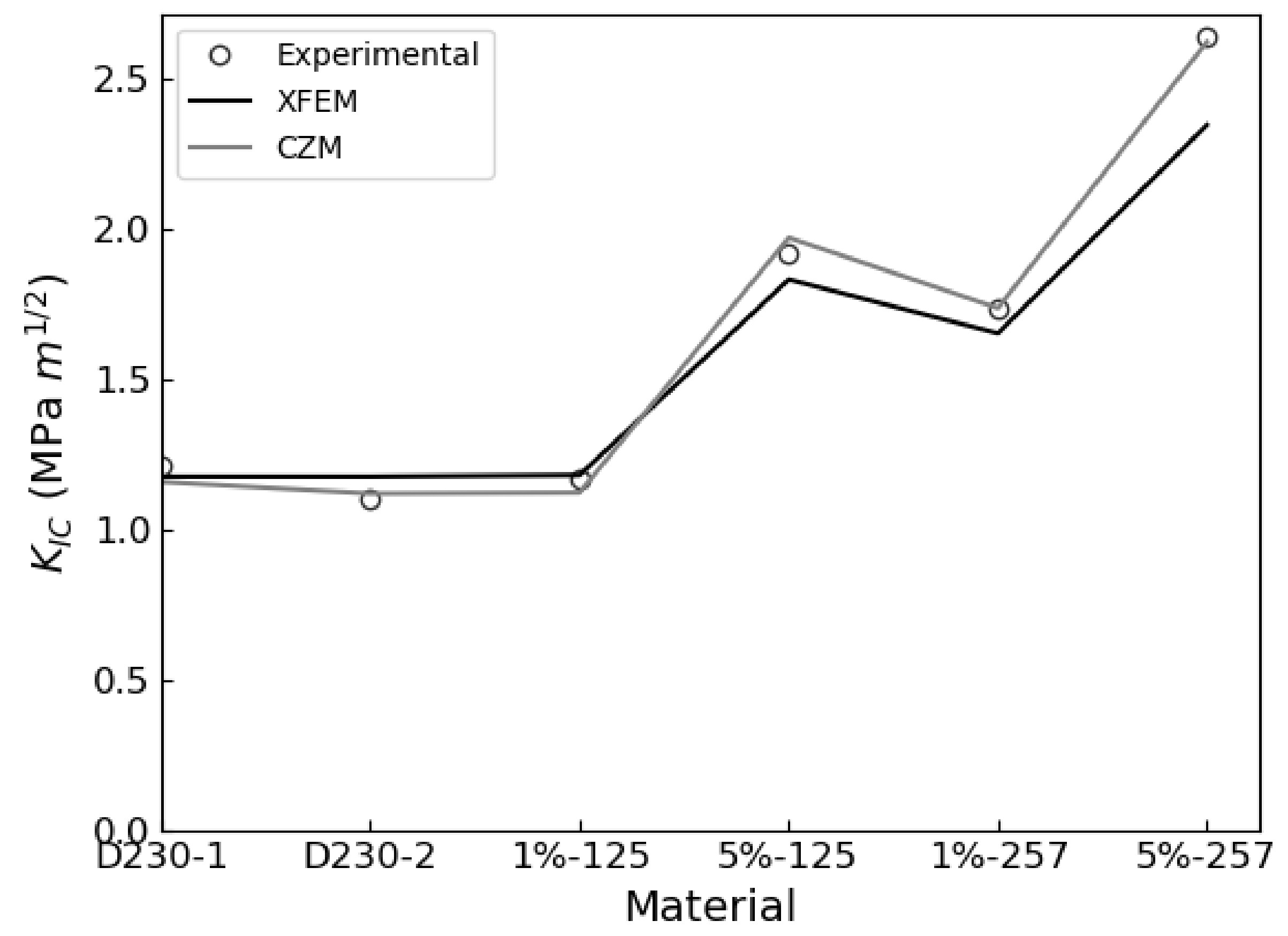
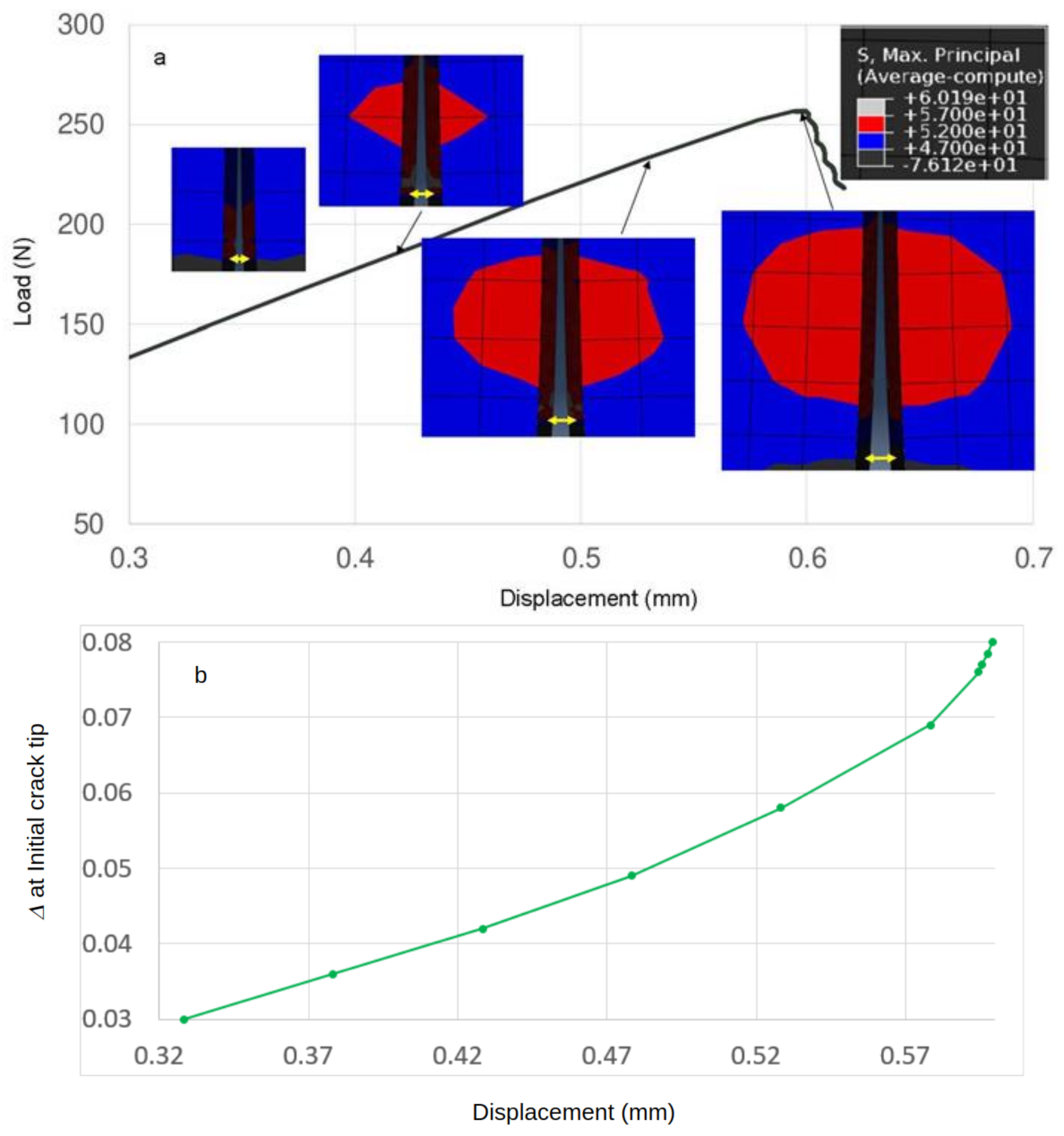
| Material | Width, W (mm) | Depth, B (mm) | Initial Crack Length, a (mm) |
|---|---|---|---|
| D230-1 | 12.74 | 6.00 | 8.26 |
| D230-2 | 12.74 | 6.10 | 5.56 |
| D230 + 1 wt% MX-125 | 12.57 | 6.10 | 6.85 |
| D230 + 5 wt% MX-125 | 12.71 | 6.10 | 6.85 |
| D230 + 1 wt% MX-257 | 12.73 | 6.21 | 6.40 |
| D230 + 5 wt% MX-257 | 12.80 | 6.11 | 4.57 |
| Material: | D230 | D230 + 1 wt% MX-125 | D230 + 5 wt% MX-125 | D230 + 1 wt% MX-257 | D230 + 5 wt% MX-257 |
|---|---|---|---|---|---|
| Yield stress (MPa): | 70.7 | 66.0 | 59.0 | 62.0 | 57.0 |
| Material | GIC (kJ/m2) | KIC (MPa∙m1/2) | Eeff (MPa) |
|---|---|---|---|
| D230-1 | 0.394 | 1.215 | 3281.1 |
| D230-2 | 0.406 | 1.105 | 2640.1 |
| D230 + 1 wt% MX-125 | 0.428 | 1.167 | 2796.1 |
| D230 + 5 wt% MX-125 | 1.431 | 1.963 | 2361.6 |
| D230 + 1 wt% MX-257 | 0.946 | 1.738 | 2800.1 |
| D230 + 5 wt% MX-257 | 2.362 | 2.640 | 2588.9 |
| Material | D230-1 | D230-2 | D230 + 1 wt% MX-125 | D230 + 5 wt% MX-125 | D230 + 1 wt% MX-257 | D230 + 5 wt% MX-257 |
|---|---|---|---|---|---|---|
| Δc (mm) | 0.0105 | 0.0108 | 0.0121 | 0.0462 | 0.0290 | 0.0791 |
| K (MPa/mm) | 110000 | 100000 | 80000 | 25000 | 40000 | 15000 |
| Simulation Parameter | Value |
|---|---|
| 2D element type | CPE4R |
| Hourglass control type | Stiffness |
| Hourglass parameter | 0.5 |
| # nodes in bottom pins | 100 |
| Contact type | Hard |
| Case | Pmax (N) | % Error | dc (mm) | % Error | KIC (MPa∙m1/2) | % Error |
|---|---|---|---|---|---|---|
| D230-1 | ||||||
| Experiment | 44.8 | 0.263 | 1.215 | |||
| CZS | 43.8 | −2.23 | 0.263 | 0 | 1.160 | −4.53 |
| XFEM | 43.5 | −2.90 | 0.241 | −8.37 | 1.179 | −2.96 |
| D230-2 | ||||||
| Experiment | 86.7 | 0.253 | 1.106 | |||
| CZS | 88.1 | 1.61 | 0.235 | −7.11 | 1.122 | 1.45 |
| XFEM | 87.2 | 1.15 | 0.228 | −9.88 | 1.113 | 0.633 |
| D230 + 1 wt% MX-125 | ||||||
| Experiment | 64.6 | 0.252 | 1.167 | |||
| CZS | 62.4 | −3.53 | 0.244 | −3.17 | 1.105 | −5.31 |
| XFEM | 65.5 | 1.39 | 0.243 | −3.57 | 1.183 | 1.37 |
| D230 + 5 wt% MX-125 | ||||||
| Experiment | 111.5 | 0.483 | 1.923 | |||
| CZS | 112.1 | 0.538 | 0.523 | 8.28 | 1.973 | 2.60 |
| XFEM | 104.2 | −6.55 | 0.481 | −0.414 | 1.834 | −4.63 |
| D230 + 1 wt% MX-257 | ||||||
| Experiment | 113.3 | 0.367 | 1.737 | |||
| CZS | 113.5 | 0.177 | 0.372 | 1.36 | 1.738 | 0.0576 |
| XFEM | 107.9 | −4.77 | 0.345 | −5.99 | 1.654 | −4.78 |
| D230 + 5 wt% MX-257 | ||||||
| Experiment | 258.6 | 0.594 | 2.640 | |||
| CZS | 257.0 | −0.619 | 0.598 | 0.673 | 2.623 | −0.644 |
| XFEM | 230.0 | −11.1 | 0.525 | −11.6 | 2.347 | −11.1 |
Publisher’s Note: MDPI stays neutral with regard to jurisdictional claims in published maps and institutional affiliations. |
© 2021 by the authors. Licensee MDPI, Basel, Switzerland. This article is an open access article distributed under the terms and conditions of the Creative Commons Attribution (CC BY) license (https://creativecommons.org/licenses/by/4.0/).
Share and Cite
Biswakarma, J.J.S.; Cruz, D.A.; Bain, E.D.; Dennis, J.M.; Andzelm, J.W.; Lustig, S.R. Modeling Brittle Fractures in Epoxy Nanocomposites Using Extended Finite Element and Cohesive Zone Surface Methods. Polymers 2021, 13, 3387. https://doi.org/10.3390/polym13193387
Biswakarma JJS, Cruz DA, Bain ED, Dennis JM, Andzelm JW, Lustig SR. Modeling Brittle Fractures in Epoxy Nanocomposites Using Extended Finite Element and Cohesive Zone Surface Methods. Polymers. 2021; 13(19):3387. https://doi.org/10.3390/polym13193387
Chicago/Turabian StyleBiswakarma, John J. S., Dario A. Cruz, Erich D. Bain, Joseph M. Dennis, Jan W. Andzelm, and Steven R. Lustig. 2021. "Modeling Brittle Fractures in Epoxy Nanocomposites Using Extended Finite Element and Cohesive Zone Surface Methods" Polymers 13, no. 19: 3387. https://doi.org/10.3390/polym13193387
APA StyleBiswakarma, J. J. S., Cruz, D. A., Bain, E. D., Dennis, J. M., Andzelm, J. W., & Lustig, S. R. (2021). Modeling Brittle Fractures in Epoxy Nanocomposites Using Extended Finite Element and Cohesive Zone Surface Methods. Polymers, 13(19), 3387. https://doi.org/10.3390/polym13193387








